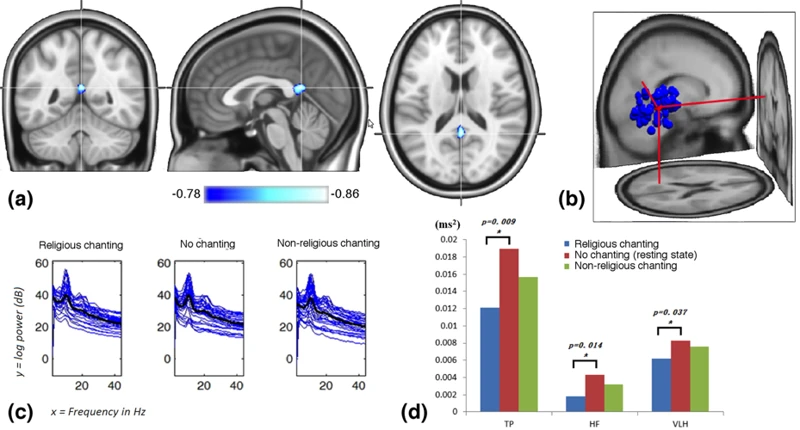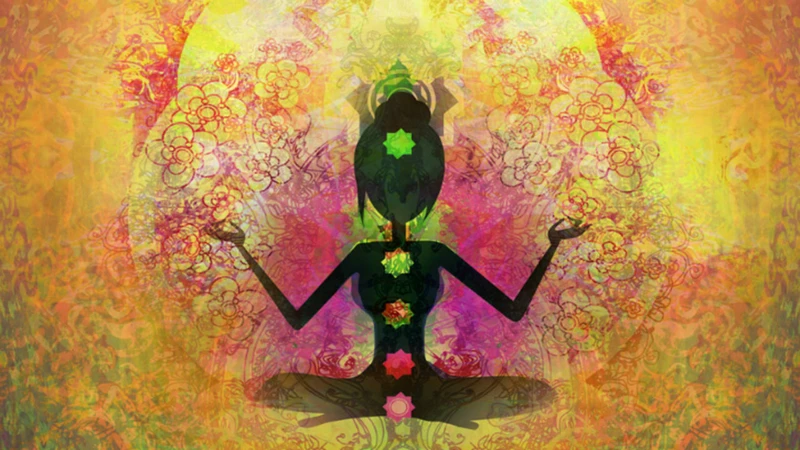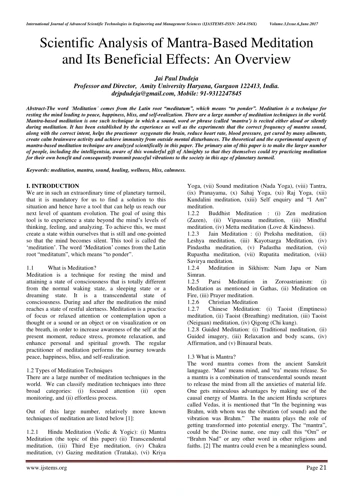As the world becomes more fast-paced and tech-dominated, people are searching for ways to quiet their minds and find inner peace. Meditation has become a popular practice among those seeking to reduce stress, improve focus, and enhance their overall well-being. Mantra meditation, in particular, holds a special place in the hearts of many. The use of repeated sounds to focus the mind and achieve a state of calm is a technique that has been honed for centuries. But how exactly does this age-old practice affect the brain? In this article, we’ll dive into the science behind mantra meditation and explore its benefits for the mind and body.
The Benefits of Meditation on the Brain

Meditation has long been known for its positive effects on both the mind and body. Research has shown that it can reduce stress, anxiety, and depression, while also improving focus, memory, and overall cognitive function. However, the benefits of meditation are not limited to just the mind and body, they also extend to the brain. The brain is a complex organ that undergoes changes during meditation which can lead to long-term improvements in its structure and function. In this section, we’ll delve into the science behind how meditation, particularly mantra meditation, can benefit the brain.
What is Mantra Meditation?
Mantra meditation is a technique that involves the repetition of a word or phrase – known as a mantra – to help focus the mind and achieve a state of calmness and relaxation. The practice has roots in Hinduism and Buddhism and has been used for centuries as a way to quiet the mind and connect with the inner self.
Here are some key characteristics of mantra meditation:
- It involves repetition: The practitioner chooses a word or phrase and repeats it over and over again, focusing on the sound and rhythm of the mantra.
- It requires concentration: Mantra meditation requires the mind to stay focused on the repeated word or phrase, which can help quiet distractions and thoughts.
- It induces relaxation: The repetitive nature of the practice can help induce a state of relaxation and calmness that can reduce stress and anxiety.
The use of a mantra in meditation has been shown to have a number of benefits for the brain and overall well-being, which we will explore in detail in the following sections.
How does it Affect the Brain?
Mantra meditation is a unique form of meditation that involves repeating a word or phrase called a mantra during the meditation practice. The use of mantras has been shown to have a significant impact on the brain. Here are some of the ways that mantra meditation affects the brain:
| Impact on the Brain | Description |
|---|---|
| Activates the Relaxation Response | Repeating a mantra triggers the relaxation response, which reduces stress and anxiety. |
| Increases Alpha Brain Waves | Mantra meditation has been shown to increase alpha brain waves, which are associated with relaxation and mental alertness. |
| Changes Brain Structure | Studies have shown that meditation can lead to changes in the brain structure, including increased cortical thickness and changes in gray matter density. |
| Enhances Emotional Processing | Mantra meditation has been shown to enhance emotional processing, making it easier to regulate emotions and respond to stressful situations. |
| Reduces Activity in the Default Mode Network | The default mode network is associated with mind-wandering and self-referential thoughts. Mantra meditation has been shown to reduce activity in this network, leading to improved focus and concentration. |
The use of a mantra during meditation has a powerful impact on the brain, leading to numerous benefits for mental and emotional health.
The Relationship between Mantra and Sound

When it comes to mantra meditation, there is often an emphasis placed on the power of sound. Many wonder about the relationship between mantra and sound and how it affects the brain. Indeed, the connection between these two elements is a fascinating one that we will explore in detail in this section. By investigating the science behind sound and its impact on the brain, we can better understand the benefits of mantra meditation and why it is such a powerful practice for overall well-being. So, let’s dive in and discover the intriguing connection between mantra and sound in the context of meditation.
What is Sound?
Sound is a form of energy that travels through different mediums such as air, water, and solids. It is defined as any vibration that can be heard by the human ear. Sound waves are created when an object vibrates, causing the particles around it to also vibrate and this vibration travels through the medium in a wave-like pattern. These waves can be measured by their frequency, which is the number of vibrations per second, and their amplitude, which is the intensity or loudness of the sound.
There are different types of sound: white noise, which is a random and constant sound, pink noise, which has a consistent frequency ratio and is found in nature, and binaural beats, which are two separate sound frequencies played in each ear that create a third frequency that can affect brain waves.
Sound can also be used as therapy to heal and improve overall well-being. This is known as sound therapy, which uses different frequencies of sound to target specific areas of the body and brain. It has been found to be effective in reducing stress, anxiety, and depression, as well as improving sleep quality and cognitive function.
How Does Sound Affect Brain Waves?
Sound has a profound influence on the brain and can affect our brainwaves by altering their frequency. Here are some ways that sound can affect brain waves:
- Binaural beats: Binaural beats are a form of sound wave therapy that involves listening to two tones of different frequencies in each ear. These sounds create a third frequency in the brain, which can synchronize brainwaves and lead to a state of deep relaxation or meditation.
- Frequency response: Different frequencies of sound can elicit different responses in the brain. For example, low-frequency sounds can stimulate relaxation, while high-frequency sounds can increase focus and alertness.
- Sound and emotion: Music and other sounds can elicit emotional responses that can affect brainwaves. For example, listening to calming music can help reduce stress levels and promote relaxation.
- Brainwave entrainment: Sound can also be used to entrain brainwaves, meaning that it can help bring the brain into a desired state. For example, listening to alpha waves can help relax the mind, while listening to beta waves can help increase focus and attention.
Sound can have a powerful impact on the brain and can influence our physiology and psychology in many ways. By harnessing the power of sound, we can improve our mental and emotional well-being and enhance our overall quality of life.
Mantra Meditation Studies

As the popularity of meditation continues to rise, more and more research is being conducted on the effects that different types of meditation have on the brain. One area of focus has been mantra meditation, a technique that involves the repetition of a specific sound or phrase. This ancient practice has been found to have numerous benefits for the mind, body and soul. In this section, we will delve into the various studies that have been conducted on mantra meditation and explore the effects it has on the brain.
The State of the Mind during Mantra Meditation
During mantra meditation, the mind enters a state of deep relaxation, where the body’s stress response is reduced. This allows individuals to feel a sense of calmness and inner peace.
Some studies have shown that during mantra meditation, there is a reduction in activity in the default mode network (DMN) of the brain. The DMN is responsible for self-referential thinking and mind-wandering, which are often associated with negative thoughts and emotions. By quieting the activity in this area of the brain, individuals may experience a decrease in negative thoughts and emotions which can lead to a reduction in symptoms of depression, anxiety, and other mental health disorders.
Additionally, some studies have shown that mantra meditation can also increase activity in the ventromedial prefrontal cortex (vmPFC) of the brain. The vmPFC is associated with positive emotions, such as love and compassion, and social behavior. Individuals who practice mantra meditation may experience an increase in positive emotions and feelings of interconnectedness with others.
Mantra meditation seems to induce a unique state of consciousness, which promotes relaxation, inner peace, and positive emotions.
Effects on Stress and Anxiety
Numerous studies have shown that mantra meditation may have a significant impact on reducing stress and anxiety levels. One study from a group of researchers at the University of Wisconsin-Madison found that individuals who practiced mindfulness meditation techniques, such as mantra meditation, experienced lower levels of stress and anxiety compared to those who did not practice these techniques.
Table: Studies on Mantra Meditation and its Effects on Stress and Anxiety
| Study | Participants | Method | Results |
|---|---|---|---|
| A Study of the Effects of Yoga Nidra and Mantra Meditation on Objective and Subjective Features of Sleep in Female Patients with Anxiety: A Randomized Controlled Trial | 60 female patients with anxiety | Participants were randomly assigned to a mantra meditation group, a yoga nidra group, or a wait-list control group. Participants in the mantra meditation group practiced the technique for 30 minutes each day for 8 weeks. | Both the yoga nidra and mantra meditation groups experienced significant improvements in sleep quality as well as reductions in anxiety and depression compared to the control group. However, the mantra meditation group had greater improvements in overall sleep quality as well as reductions in anxiety compared to the yoga nidra group. |
| The Effects of Mantra Meditation on Mindfulness, Affect, and Anxiety in Depressed Women | 60 women with depression | Participants were randomly assigned to either a mantra meditation group or a control group. The mantra meditation group practiced the technique for 20 minutes each day for 8 weeks. | Participants in the mantra meditation group had significant improvements in mindfulness, positive affect, and reductions in anxiety and depressive symptoms compared to the control group. |
These studies suggest that mantra meditation has the potential to reduce levels of stress and anxiety in individuals. It is important to note that while the studies focused on specific populations such as female patients with anxiety and women with depression, the benefits of mantra meditation on reducing stress and anxiety may extend to a wider population.
In addition to the studies mentioned above, other research has found that regular practice of mantra meditation can lead to changes in the brain that may help regulate emotions and reduce stress. By practicing mantra meditation regularly, individuals may be able to better manage their stress and anxiety levels and improve their overall well-being.
Mantra Meditation and Overall Well-being
Research has shown that mantra meditation can have a significant impact on overall well-being. Studies have shown that regular practice of mantra meditation can reduce stress, anxiety, and depression, while improving mood and cognitive function.
| Benefits of Mantra Meditation for Overall Well-being |
|—————————————————-|
| 1. Reduces stress and anxiety. |
| 2. Improves mood and emotional well-being. |
| 3. Enhances cognitive function including attention, memory, and focus. |
| 4. Decreases symptoms of depression. |
| 5. Boosts the immune system. |
Additionally, practicing mantra meditation has been linked to decreased inflammation and improved cardiovascular health. It has also been found to increase feelings of compassion and empathy towards others, which can improve relationships and social connections.
The benefits of mantra meditation on the brain and overall well-being are clear. Incorporating this practice into one’s daily routine has the potential to improve both mental and physical health, leading to a happier and healthier life.
Mantra Meditation Techniques
Now that we understand the science behind mantra meditation and its benefits for the brain, let’s delve into the various techniques involved in this ancient practice. There are several components to mantra meditation that can make it highly effective, from selecting the right mantra to understanding how to use a mala bead. With these tools, you can start your mantra meditation journey and experience the many positive effects on your mind and body. So, let’s explore the techniques for successful mantra meditation.
How to Get Started with Mantra Meditation
If you’re new to mantra meditation, getting started might seem intimidating, but it’s actually quite simple. Here are some steps to help you begin:
- Find a quiet space: It’s important to have a quiet space where you won’t be disturbed during your practice.
- Get comfortable: Sit comfortably in a cross-legged position with your back straight, or sit in a chair with your feet flat on the ground, and your back straight.
- Choose a time: Select a time when you can devote at least 15-20 minutes to your practice.
- Choose a mantra: Select a mantra that resonates with you. It can be a word or sound that holds special meaning for you, or one that has been traditionally used for meditation. There are also many guided mantra meditations available online to help you get started.
- Start chanting: Begin by chanting your chosen mantra out loud, or silently in your mind. Focus your attention on the sound of the mantra, and let go of any other thoughts that come into your mind.
- Repeat: Repeat the mantra for the duration of your meditation practice, typically for 15-20 minutes.
- End your practice: When you’re ready to end your practice, slowly stop chanting the mantra, and take a few deep breaths. Take a moment to sit quietly and reflect on how you feel.
Remember, the most important aspect of mantra meditation is creating a regular practice. Even if you start with just a few minutes a day, you’ll see the benefits of meditation over time.
Choosing a Mantra
Choosing the right mantra is a crucial step in mantra meditation practice. A mantra is a sound or phrase that is repeated during meditation to help focus and quiet the mind. Each mantra has a unique vibration that affects the mind and body in different ways. It’s important to choose a mantra that resonates with you and aligns with your intention for meditation.
There are different approaches to choosing a mantra, depending on personal preferences and spiritual beliefs. Here are a few options:
| Approach | Explanation |
|---|---|
| Sanskrit mantras | Some practitioners prefer to use traditional Sanskrit mantras that have been passed down for centuries. These mantras usually have spiritual meanings and are believed to have powerful effects on the mind and body. Examples include “Om,” “So Hum,” and “Om Namah Shivaya.” |
| Personal intention | Others choose a mantra based on a personal intention or goal they have for their meditation practice. For example, if you seek more peace or harmony in your life, you may choose a mantra that reflects these qualities, such as “I am peace” or “I am harmony.” |
| Guided meditation | Guided meditation apps or classes may provide a list of mantras to choose from based on specific themes or intentions. This can be a helpful way to discover new mantras and incorporate them into your practice. |
| Intuition | Ultimately, the best mantra for you is the one that speaks to you intuitively. This may involve trying out different mantras and seeing which one resonates with you the most. |
Once you have chosen a mantra, it’s helpful to repeat it during meditation with a sense of devotion and focus. Using a mala bead or counting the repetitions can help maintain concentration and keep track of the length of your practice. Remember that the most important aspect of mantra meditation is not the specific mantra itself, but the intention and focus you bring to your practice.
Using a Mala Bead
The use of a mala bead is a popular technique for keeping track of mantras during meditation. A mala bead is a string of 108 beads, with one larger bead, called the guru bead or summit bead, at the center.
To use a mala bead, hold it in your right hand and start at the guru bead, using your thumb to count each bead as you repeat your mantra. When you reach the guru bead again, it signifies 100 repetitions. The extra eight beads are meant to compensate for any omissions or mistakes made during the meditation.
The mala bead serves as a physical anchor for the mind, helping to reduce distractions and maintain focus on the mantra. It also provides a tactile sensation which can be soothing and calming to the mind, aiding in relaxation and stress relief.
Some people also imbue their mala bead with a personal intention or use it as a sacred object for additional spiritual benefits during the meditation practice.
It’s essential to keep your mala bead clean and properly stored when not in use, as it can carry the energy of your meditation practice. This way, the beads will continue to provide a consistent and beneficial experience for your mantra meditation.
| Pros | Cons |
|---|---|
| Maintains focus on the mantra | May not be comfortable for everyone to use |
| Soothes and calms the mind with tactile sensation | Needs to be kept clean and stored properly |
| Can hold personal intention for spiritual benefits | May not align with a non-spiritual practice |
Conclusion
In conclusion, the practice of mantra meditation has numerous benefits for the brain and overall well-being. By using a specific word or phrase as a mental focus, mantra meditation creates a calming and focusing effect on the brain, promoting relaxation and reducing stress and anxiety.
Studies have shown that mantra meditation can also have a positive impact on physical and mental health, reducing symptoms of depression and improving cognitive function. This powerful practice can even enhance self-awareness and self-realization, leading to a deeper understanding of oneself and the world around us.
The relationship between mantra and sound is a crucial aspect of how mantra meditation affects the brain. Sound waves can stimulate different types of brain waves, and the use of a mantra as a sound source can have a profound impact on the mind.
To get started with mantra meditation, it is essential to choose a word or phrase that resonates with your personal beliefs and values. Mala beads can also be used as a tool for counting and focusing during meditation.
Overall, the science behind mantra meditation shows that this practice can have significant benefits for the brain and overall well-being. By incorporating mantra meditation into our daily routine, we can access a deeper sense of calm and clarity and experience the many benefits of this powerful practice.
Frequently Asked Questions
What is the history of Mantra meditation?
Mantra meditation has been practiced for thousands of years in many different cultures, including Hinduism, Buddhism, and Jainism. It was originally used as a means of connecting with a spiritual or divine force, and later evolved into a form of meditation for relaxation and stress relief.
Can anyone practice Mantra meditation?
Yes, anyone can practice mantra meditation regardless of their age or religious beliefs. It is a simple and effective method that can be easily incorporated into anyone’s daily routine.
Do I need to be in a certain position or location to practice Mantra meditation?
No, you can practice mantra meditation in any comfortable position and location where you can focus without distractions. It can be done sitting, standing, or even lying down.
How long does it take to see the benefits of Mantra meditation?
The benefits of mantra meditation can be felt almost immediately, especially in terms of relaxation and stress relief. However, for long-term benefits such as improved cognitive function and emotional well-being, consistent practice over a period of weeks or months is recommended.
Can Mantra meditation be used to treat mental health conditions?
While mantra meditation is not a replacement for professional mental health treatment, it can be a helpful supplementary practice for managing symptoms of anxiety, depression, and other mental health conditions. It is always best to consult with a mental health professional before beginning any new treatment or practice.
Do I have to chant the mantra out loud?
No, the mantra can be chanted silently in your mind. The key is to focus on the sound and vibration of the mantra, whether it is spoken aloud or thought silently.
What if I can’t focus on the mantra?
It is common for the mind to wander during meditation, especially at first. If you find yourself distracted, simply bring your attention back to the sound and vibration of the mantra without judgement or frustration. Like any skill, it takes practice and patience to improve.
Is it necessary to use a specific mantra?
No, any word or phrase can be used as a mantra. However, traditional mantras such as “Om” or “So Hum” have been used for centuries and may have specific spiritual or energetic associations.
Can I practice Mantra meditation as part of a larger spiritual practice?
Yes, many religious and spiritual practices incorporate mantra meditation as a form of prayer or devotion. However, it can also be practiced as a standalone method for relaxation and stress relief.
Is Mantra meditation a form of mindfulness meditation?
While both mantra and mindfulness meditation involve focused attention, they are different techniques. Mindfulness meditation involves observing and accepting the present moment without judgement, while mantra meditation involves repeating a specific sound or phrase to focus the mind.








